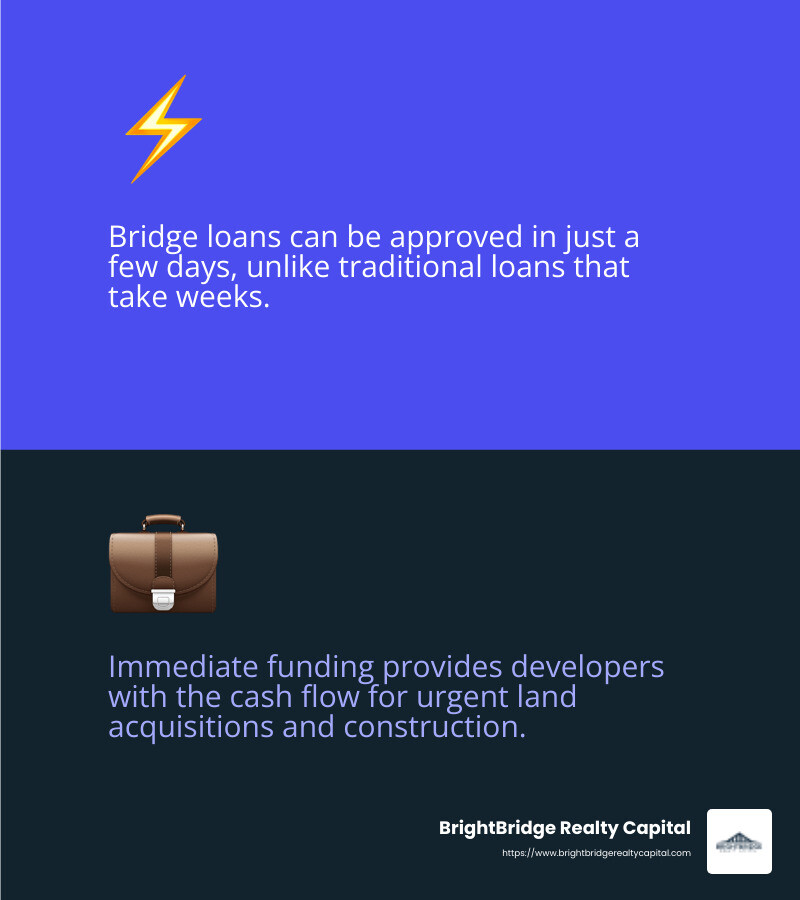Building Bridges: A Guide to Real Estate Development Financing

Bridge financing real estate development is a pivotal tool for savvy investors seeking swift and flexible solutions. These short-term loans fill the gap when purchasing a new property before selling the current one. Here's what you need to know in a nutshell:
- Quick Access: Ideal for investors needing immediate funds.
- Flexible Terms: Custom to meet unique investment needs.
- Higher Interest Rates: A trade-off for speed and convenience.
Investors often face the challenge of synchronizing property transactions without financial strain. Bridge loans not only provide the necessary liquidity but also empower real estate investors to act swiftly on opportunities. They offer a way to bridge financial gaps, ensuring that important deals aren't missed. Companies like BrightBridge Realty Capital specialize in providing these rapid financing solutions across the nation, ensuring that transactions are both smooth and expedient.
Stay with us as we unfold the potential of bridge loans and how these financing instruments can be a game changer in the real estate development arena.

Bridge financing real estate development terms you need:
Understanding Bridge Financing in Real Estate Development
Bridge financing is a short-term loan designed to provide immediate funding for real estate developers. This type of financing is crucial for those who need quick access to capital to seize opportunities without delay.
What Makes Bridge Financing Unique?
Short-Term Loan: Bridge loans typically last between 12 to 24 months. This short duration makes them ideal for developers who need temporary funding while awaiting longer-term financing solutions.
Asset-Based Lending: Unlike traditional loans that heavily weigh credit scores, bridge loans are secured by the real estate asset itself. This means the property's value plays a crucial role in the approval process, making it accessible even to those with less-than-perfect credit.
Flexible and Fast: Developers benefit from the flexibility of bridge loans, which can be custom to specific project needs. The approval process is generally quicker than conventional loans, allowing developers to act swiftly on investment opportunities.
How Does Bridge Financing Benefit Developers?
Immediate Liquidity: Developers can quickly acquire the funds needed to purchase land, secure permits, or kickstart construction projects. This rapid access to capital is essential in competitive markets.
High Loan-to-Value Ratios: Bridge loans often cover up to 80% of the project's financing needs, reducing the risk of project delays due to funding shortages.
Interest-Only Payments: During the loan term, developers usually pay only the interest, which helps manage cash flow during the initial phases of a project.
In summary, bridge financing real estate development offers a strategic advantage by providing the necessary financial agility to steer the dynamic real estate market. Developers can leverage these loans to maintain momentum in their projects, ensuring they are well-positioned to capitalize on emerging opportunities.
Join us next as we dig into the different types of bridge loans available for real estate development and how they cater to diverse investment needs.
Types of Bridge Loans for Real Estate Development
Bridge loans come in various forms to suit different real estate development needs. Let's explore the main types: commercial bridge loans, residential bridge loans, and hard money loans.
Commercial Bridge Loans
Commercial bridge loans are designed to provide short-term financing for commercial property projects. These loans are ideal for developers looking to purchase or renovate commercial spaces like office buildings, retail centers, or industrial properties.
- Flexible Terms: Commercial bridge loans offer flexible terms, allowing developers to tailor the loan to their project's specific timeline and needs.
- Quick Approval: These loans are known for their fast approval process, which is crucial for developers who need to act quickly in competitive markets.
- High Loan-to-Value Ratios: Developers can often secure financing up to 80% of the property's value, making it easier to manage project costs.
Residential Bridge Loans
Residential bridge loans cater to developers involved in residential projects, whether building new homes or renovating existing ones. These loans are particularly useful for ensuring smooth transitions between buying and selling properties.
- Short-Term Funding: Typically lasting 6-12 months, these loans help bridge the financial gap when developers need to secure a new property before selling an existing one.
- Collateral-Based: The loan is secured against the current property, allowing developers to leverage the equity they have built up.
- Ideal for Flippers: Real estate flippers often use residential bridge loans to quickly purchase and renovate homes for resale.
Hard Money Loans
Hard money loans are a type of bridge loan backed by the property's value rather than the borrower's creditworthiness. They are often used in both commercial and residential real estate development.
- Asset-Based: These loans focus on the property's value, making them accessible to developers with less-than-perfect credit.
- Higher Interest Rates: Due to the increased risk for lenders, hard money loans typically come with higher interest rates compared to traditional loans.
- Fast Funding: Like other bridge loans, hard money loans are known for their rapid approval and funding process, allowing developers to seize opportunities quickly.

Bridge financing real estate development offers a range of options to suit various project types and financial situations. Whether you're working on a commercial project, a residential development, or need a hard money loan for quick funding, there's a bridge loan custom to your needs.
Next, we'll dive into the benefits of bridge financing for developers and how it supports their goals in the ever-changing real estate landscape.
Benefits of Bridge Financing for Developers
Bridge financing offers developers several advantages that can make a significant difference in their projects. Let's explore the key benefits: quick access to funds, flexible terms, and high loan-to-value ratios.
Quick Access to Funds
One of the main advantages of bridge financing is the speed at which developers can access funds. Unlike traditional loans, which can take weeks or even months to process, bridge loans are designed for rapid approval and funding. This quick access is crucial for developers who need to seize opportunities in competitive markets or who face tight timelines.
- Fast Approval Process: Developers often receive approval in a matter of days, allowing them to act swiftly on property acquisitions or renovations.
- Immediate Liquidity: With bridge loans, developers gain immediate cash flow to cover urgent expenses like land acquisition or construction costs.

Flexible Terms
Bridge loans are known for their flexibility, offering terms that can be custom to the unique needs of each project. This flexibility extends to the loan structure, repayment options, and even the use of funds.
- Customizable Loan Structures: Developers can negotiate terms that align with their project's timeline and financial requirements.
- Interest-Only Payments: During the construction phase, developers typically only pay interest on the loan, easing cash flow pressures until the project is completed.
High Loan-to-Value Ratios
Bridge financing often provides developers with high loan-to-value (LTV) ratios, which means they can borrow a significant portion of the project's cost. This high LTV is beneficial for developers who need substantial funding without tapping into their own reserves.
- Up to 80% LTV: Developers can secure financing up to 80% of the property's value, reducing the need for additional capital.
- Supports Large-Scale Projects: High LTV ratios make it easier to manage costs for larger projects, ensuring developers can move forward without financial constraints.
In summary, bridge financing real estate development offers developers quick access to funds, flexible terms, and high loan-to-value ratios. These benefits make bridge loans an attractive option for developers looking to steer the complexities of real estate projects efficiently.
Next, we'll explore how bridge loans work in real estate development, including critical aspects like loan-to-value ratios, interest rates, and collateral requirements.
How Bridge Loans Work in Real Estate Development
Understanding how bridge financing real estate development operates is crucial for developers aiming to leverage its benefits. Let's dig into the key components: loan-to-value ratios, interest rates, and collateral requirements.
Loan-to-Value Ratio
A loan-to-value (LTV) ratio is a measure used by lenders to determine how much they will lend against a property relative to its value.
- High LTV Ratios: Bridge loans typically offer LTV ratios of up to 80%. This means developers can finance a significant portion of their project costs, providing them with substantial upfront capital.
- Benefits for Developers: High LTV ratios reduce the need for developers to use their own funds, allowing them to allocate resources more effectively across multiple projects.
Interest Rates
Interest rates for bridge loans are generally higher than those for conventional loans, reflecting the short-term and higher-risk nature of the loan.
- Higher Rates: Bridge loans often have rates around 2% above the prime rate. This is due to the expedited process and the temporary nature of the financing.
- Interest-Only Payments: During the term of the bridge loan, developers may have the option to make interest-only payments. This can ease cash flow during the construction or renovation phases.
Collateral Requirements
Collateral is a critical aspect of securing a bridge loan. The property being developed usually serves as the collateral.
- Property as Collateral: The existing or future property value is used to secure the loan, which reduces the lender's risk.
- Asset-Based Lending: Because bridge loans are often asset-based, the focus is more on the value of the property than the borrower's credit score. This makes it accessible to a wider range of developers.
In real estate development, bridge financing provides a strategic tool for developers to access funds quickly, manage large projects, and steer financial challenges. By understanding the intricacies of LTV ratios, interest rates, and collateral requirements, developers can make informed decisions that align with their project goals.
Next, we'll address some frequently asked questions about bridge financing in real estate development, including the differences between bridge loans and traditional loans, and the risks involved.
Frequently Asked Questions about Bridge Financing Real Estate Development
What is a bridge loan in real estate?
A bridge loan in real estate is a short-term loan designed to provide immediate funding. It's a form of interim financing that helps developers and investors cover costs while waiting for long-term financing or the sale of a property. These loans typically last from 12 to 24 months, making them ideal for quick transactions and urgent financial needs.
How do bridge loans differ from traditional loans?
Bridge loans stand out from traditional loans in several key ways:
Faster Approval: Bridge loans have a quicker approval process, often closing in as little as a week. This is crucial for seizing time-sensitive opportunities.
Higher Interest Rates: Due to their short-term nature and expedited processing, bridge loans generally come with higher interest rates. These rates can start around 9.99%, which is higher than most conventional loans.
Flexibility: Bridge loans are more flexible in terms of underwriting and documentation. They often focus on the value of the property rather than the borrower's credit score, making them accessible to a broader range of investors.
What are the risks associated with bridge loans?
While bridge loans offer many benefits, they also come with certain risks:
High Interest: The higher interest rates mean that the cost of borrowing is more expensive. This can impact the overall profitability of a project if not managed carefully.
Dual Payments: If a borrower is using a bridge loan to purchase a new property before selling an existing one, they may face dual payments. This means making payments on both the bridge loan and any existing mortgage, which can strain cash flow.
Understanding these aspects of bridge financing real estate development helps developers and investors make informed decisions. It's about balancing the need for quick access to funds with the costs and risks involved.
Conclusion
At BrightBridge Realty Capital, we understand that every real estate development project is unique, and so are the financing needs of our clients. That's why we specialize in providing customized solutions for bridge financing real estate development. Our approach is simple: offer fast, flexible funding to keep your projects moving forward.
One of our key advantages is our ability to offer fast closings. We know that in real estate, timing is everything. Opportunities can arise unexpectedly, and having the capital ready to seize them can make all the difference. That's why we pride ourselves on our ability to close deals quickly—often within a week—ensuring that you don't miss out on lucrative opportunities.
Our process is streamlined and efficient, cutting out intermediaries to offer competitive rates directly to you. This direct lending approach not only speeds up the process but also helps reduce costs, making it a win-win for developers looking to maximize their investments.
Whether you're flipping properties, starting a new construction project, or expanding your rental portfolio, BrightBridge Realty Capital is here to support your journey. With our expertise in bridge financing real estate development, we're committed to helping you bridge the gap between your current situation and your future goals.
Ready to explore how our customized solutions can work for you? Learn more about our services and take the next step in your real estate development journey with confidence.


